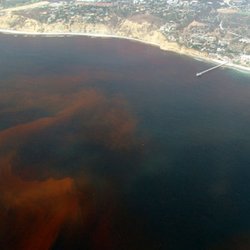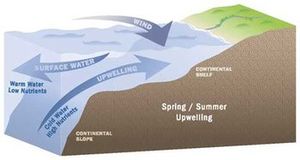Bottom-up control
Bottom Up Control
| Topics: |

Variation in distribution and abundance of organisms is dependent on interactions between physical and biotic factors. "bottom:up" effects refer to controls on the abundance and/or community structure of organisms that derive from supply of resources (light or nutrients for plants, prey organisms for animals) or from physical factors such as temperature of the environment. That is, bottom:up controls arise from near the bottom of the food web, below the trophic level in question. In the case of plants, their growth is controlled by the availability of nutrients and sunlight (Solar radiation). For example, farmers use fertilizers or manure to increase the nutrients in the soil and promote crop growth. Soil nutrient availability can directly enhance vegetative growth, flowering, and fruiting. Nutrient addition to alpine shrubs can also increase pollinator visitation, which could affect seed output. Thus, availability of soil N or other limiting nutrients can produce strong positive bottom:up effects on the reproductive output of plants.
In many temperate-zone areas, aquatic phytoplankton populations undergo large increases (blooms) in the spring when duration of sunlight increases and high levels of nutrients are in the water following winter. The bloom ceases and populations decline when they have used up all the nutrients in the water. Animal populations are dependent on the availability of food, so the phytoplankton bloom provides more food for the zooplankton, whose populations subsequently increase. Some Planktonic populations are regulated by a combination of both resource limitation from the bottom up and predation from the top down, so the increasing zooplankton populations serve to check the growth of the phytoplankton population.
Increased resources such as light or nutrients may increase abundances of not only plants but also animals higher in the food web, in which case the community or ecosystem as a whole (as opposed to a single population or trophic level) is said to show bottom:up control. It is not always clear, however, how many levels up such bottom:up effects can be seen. Does more light or higher nutrients that cause a phytoplankton bloom ultimately result in more fish? Not necessarily. For example, in freshwater (Freshwater biomes) systems, bottom:up control (i.e. nutrient enhancement) usually affects only the next trophic level up, beyond which the effects are dampened. Similarly, in marine systems, bottom:up effects are sometimes only manifested one trophic level up. For example, nutrient additions lead to increases in phytoplankton biomass, but not necessarily increases at higher levels.
However, in some cases, bottom:up effects can be seen two or more levels up. In a plant/aphid/ant food chain, plant genotype strongly affected the aphid population’s growth rate and also had direct and indirect effects on the third trophic level, affecting the abundance of aphid-tending ants and the richness of predators like ladybugs that feed on aphids. This shows that bottom up effects (plant genotype in this case) can have effects two levels up and can be one of the most important ecological factors shaping communities with multiple trophic levels.

On large scales, there is clear evidence of bottom:up control of ecosystem biomass and productivity. For example, at global scales in the marine environment the greatest biomass of fishes, seabirds and marine mammals are found in regions with highest primary production, e.g. up-welling regions of continental shelves. These large-scale animal distribution patterns are driven by food availability, not the absence of predators. At more local scales however, top-down control in the form of predation ([[top down] effects]) often shapes distributions and abundance of prey organisms, and even plants. One large-scale study looked at annual fish catch data and chlorophyll a measurements (indication of phytoplankton) for the continental margin of western North America and found substantial alongshore variation in primary production that was highly correlated with the variation in fish yield. Zooplankton data confirmed strong bottom:up trophic linkages between phytoplankton, zooplankton, and resident fish. Yet, top-down impacts on marine pelagic communities are also being found with increasing regularity.
In the deep sea environment, fish studied over a 15-year period showed a threefold increase in abundance, which appeared to be related to an increase in the available food. Changes in the deep-sea were likely caused by changes at the ocean surface by El Niño and La Niña events, which can bring more nutrients to surface waters, stimulating phytoplankton. While animals near the surface can benefit quickly, it may take months to years for changes to extend fully to the ocean bottom, increasing abundance of slow-growing bottom:dwelling invertebrates that are part of the food supply of deep-sea fishes.
References
- Bailey, D.M., H. Ruhl and K. L. Smith Jr. 2006. Long-tem change in benthopelagic fish abundance in the abyssal northeast Pacific Ocean. Ecology 87:549-555.
- Frank K.T., Petrie B. & Shackell N.L. 2007. The ups and downs of trophic control in continental shelf ecosystems. Trends in Ecology & Evolution 22:236-242.
- Johnson, M.T. 2008. bottom:up effects of plant genotype on aphids, ants, and predators. Ecology 89:145-54.
- Ware, D.M. and R.E. Thomson 2005. bottom:up ecosystem trophic dynamics determine fish production in the Northeast Pacific. Science 308:1280-1284.

0 Comments